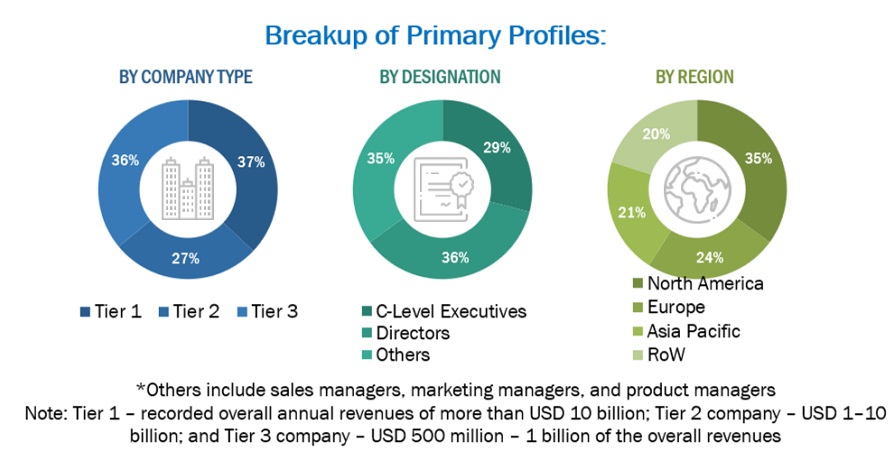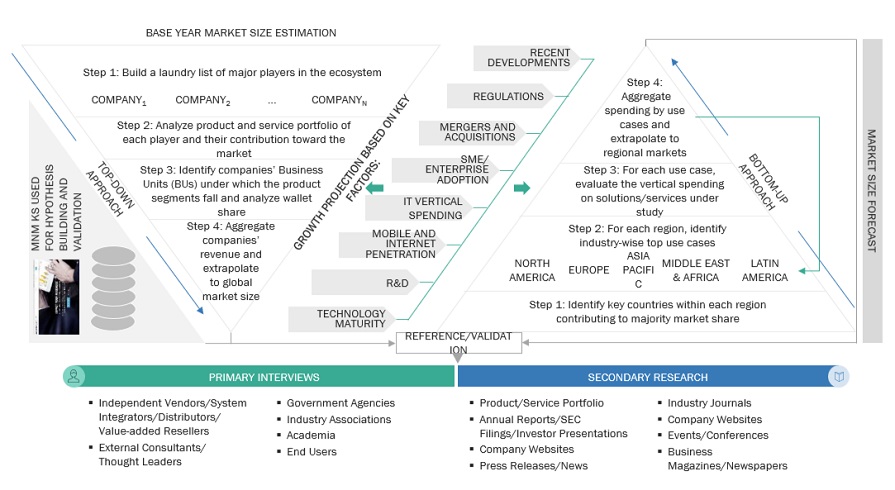The study involved four major activities in estimating the video streaming software market. We performed extensive secondary research to collect information on the market, the competitive market, and the parent market. The next step was to validate these findings, assumptions, and sizing with industry experts across the value chain through primary research. Both top-down and bottom-up approaches were employed to estimate the complete market size. After that, we used the market breakup and data triangulation procedures to estimate the market size of the various segments in the video streaming software market.
Secondary Research
In the secondary research process, various sources were referred to to identify and collect information for this study. Secondary sources included annual reports, press releases, and investor presentations of companies; white papers, journals, and certified publications; and articles from recognized authors, directories, and databases. The data was also collected from other secondary sources, such as journals, government websites, blogs, and vendors' websites.
Primary Research
Primary sources were several industry experts from the core and related industries, preferred software providers, hardware manufacturers, distributors, service providers, technology developers, alliances, and organizations related to all segments of the industry's value chain. In-depth interviews were conducted with primary respondents, including key industry participants, subject-matter experts, C-level executives of key market players, and industry consultants, to obtain and verify critical qualitative and quantitative information and assess the market's prospects.
We conducted primary interviews to gather insights, such as market statistics, the latest trends disrupting the market, new use cases implemented, data on revenue collected from products and services, market breakups, market size estimations, market forecasts, and data triangulation. Primary research also helped understand various technology trends, segmentation types, industry trends, and regions. Demand-side stakeholders, such as Chief Information Officers (CIOs), Chief Technology Officers (CTOs), and Chief Security Officers (CSOs); the installation teams of governments/end users using video streaming software solutions & services; and digital initiatives project teams, were interviewed to understand the buyer's perspective on suppliers, products, service providers, and their current use of services, which would affect the overall video streaming software market.

To know about the assumptions considered for the study, download the pdf brochure
Market Size Estimation
We used top-down and bottom-up approaches to estimate and forecast the video streaming software and other dependent submarkets. We deployed a bottom-up procedure to arrive at the overall market size using the revenues and offerings of key companies in the market. With data triangulation methods and validation through primary interviews, this study determined and confirmed the exact value of the overall parent market size. We used the overall market size in the top-down procedure to estimate the size of other individual markets via percentage splits of the market segments.
We used top-down and bottom-up approaches to estimate and validate the video streaming software market and other dependent subsegments.
The research methodology used to estimate the market size included the following details:
-
We identified key players in the market through secondary research. We then determined their revenue contributions in the respective countries through primary and secondary research.
-
This procedure included studying top market players' annual and financial reports and extensive interviews for key insights from industry leaders, such as Chief Executive Officers (CEOs), VPs, directors, and marketing executives.
-
All percentage splits and breakups were determined using secondary sources and verified through primary sources.
All the possible parameters that affect the market covered in this research study have been accounted for, viewed in extensive detail, verified through primary research, and analyzed to get the final quantitative and qualitative data. This data is consolidated and added with detailed inputs and analysis from MarketsandMarkets.
Video streaming software market: Top-down and Bottom-up approaches

To know about the assumptions considered for the study, Request for Free Sample Report
Data Triangulation
After arriving at the overall market size, the market was split into several segments and subsegments—using the market size estimation processes as explained above. Where applicable, data triangulation and market breakup procedures were employed to complete the overall market engineering process and determine each market segment's and subsegment's exact statistics. The data was triangulated by studying several factors and trends from the video streaming software market's demand and supply sides.
Market Definition
Video streaming enables enterprises to continuously deliver video data to a remote user over a network or the internet. A streaming provider offers various hosting options, such as on-premises and cloud-based, to meet users' needs. Video content such as TV shows, movies, and live streams is delivered on-demand or via live broadcast, usually from a cloud-based network. The video streaming software empowers enterprises to create, store, manage, monitor, and share video content across their systems for internal communication or to present the information externally to a live audience. With different streaming types, such as on-demand or live stream videos, customers can select and watch content with the help of web-based and mobile app-based delivery channels.
Key Stakeholders
-
Video streaming software vendors
-
Technology partners
-
Consulting firms
-
Resellers and distributors
-
Enterprise users
-
Technology providers
-
Value-Added Resellers (VARs)
-
End users
-
System integrators
Report Objectives
-
To define, describe, and forecast the video streaming software market based on offering (solutions and services), streaming type, deployment mode, delivery channel, monetization model, connected devices, verticals, and regions
-
To provide detailed information about the major factors (drivers, opportunities, restraints, and challenges) influencing the growth of the market
-
To analyze the opportunities in the market for stakeholders by identifying the high-growth segments of the market
-
To forecast the market size concerning five regions—North America, Europe, Asia Pacific, the Middle East & Africa, and Latin America
-
To analyze the subsegments of the market concerning individual growth trends, prospects, and contributions to the overall market
-
To profile the key players of the market and comprehensively analyze their market size and core competencies
-
To track and analyze the competitive developments, such as product enhancements, product launches, acquisitions, partnerships, and collaborations, in the video streaming software market globally
-
To profile the key players in the market and comprehensively analyze their market share/ranking and core competencies across segments and subsegments.
-
To track and analyze the competitive developments, such as mergers and acquisitions, product developments, and partnerships and collaborations in the market.
Available Customizations
With the given market data, MarketsandMarkets offers customizations per the company's specific needs. The following customization options are available for the report:
Product Analysis
-
The product matrix provides a detailed comparison of each company's product portfolio.
Geographic Analysis
-
Further breakup of the Asia Pacific market into countries contributing 75% to the regional market size
-
Further breakup of the North American market into countries contributing 75% to the regional market size
-
Further breakup of the Latin American market into countries contributing 75% to the regional market size
-
Further breakup of the Middle Eastern & African market into countries contributing 75% to the regional market size
-
Further breakup of the European market into countries contributing 75% to the regional market size
Company Information
-
Detailed analysis and profiling of additional market players (up to 5)



Growth opportunities and latent adjacency in Video Streaming Software Market